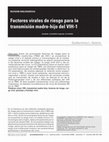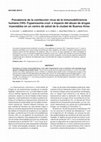Papers by Guillermina Dolcini
Journal of Thermal Biology
I Congreso de Microbiología Veterinaria (CMV) (La Plata, modalidad virtual, 4, 5 y 6 de agosto de 2021), 2021
Molecular Immunology, 2019

Journal of dairy science, 2009
Due to the wide dissemination of bovine leukemia virus (BLV) infection among dairy cattle, contro... more Due to the wide dissemination of bovine leukemia virus (BLV) infection among dairy cattle, control and eradication programs based on serological detection of infected cattle and subsequent culling face a major economic task. In Argentina, genetic selection of cattle carrying alleles of the bovine leukocyte antigen (BoLA) DRB3.2 gene associated with BLV-infection resistance, like *0902, emerges as the best additional tool toward controlling virus spread. A potential risk in expanding or segregating BoLA selected populations of cattle is that it might increase susceptibility to other common viruses. Special concern raises the strong association found between low proviral load and low antibody titer against major BLV structural proteins. This phenomenon might depend on host genetic factors influencing other viruses requiring, unlike BLV, strong and long-lasting humoral immune response to prevent infection. In this study, we demonstrate that there is no association among neutralizing an...

PubMed, Mar 30, 2023
The retrovirus bovine leukemia virus (BLV) might produce abnormal immune function, associated wit... more The retrovirus bovine leukemia virus (BLV) might produce abnormal immune function, associated with susceptibility to developing other infectious diseases, including mastitis. This study aimed to determine the proviral load and cytokines gene expression in peripheral blood mononuclear cells (PMBC) and milk somatic cells (SC) in BLV-infected and non-infected cattle. Of 27 BLV-infected cows in PBMC, 17 (62.96%) had a high proviral load (HPL), and 10 (37.04%) had a low proviral load (LPL). All SC samples had low proviral load (LPL-SC). Higher IFN-γ and IL-10 expression, and lower IL-12 and IL-6 expression, were found in PBMC from BLV-infected compared to BLV non-infected cattle. Moreover, higher IFN-γ, IL-12, and IL-6 expression, and lower IL-10 expression were observed in cattle with LPL-PBMC compared to HPL-PBMC. In milk samples, lower IFN-γ and higher IL-12 mRNA expression were observed in LPL-SC compared to BLV non-infected cattle in SC. IL-10 and IL-6 expression mRNA was significantly lower in LPL-SC than in SC from BLV non-infected cattle. This study shows that milk SC maintains lower proviral load levels than PBMC. This first report on Th1 and Th2 cytokines expression levels in SC may be relevant to future control strategies for BLV infection, mastitis, and udder health management.
Sociedad de Medicina Veterinaria, Sep 1, 2020

Brazilian Journal of Animal and Environmental Research, 2022
El virus de la leucosis bovina (BLV) es el agente etiológico de la leucosis enzoótica bovina (LEB... more El virus de la leucosis bovina (BLV) es el agente etiológico de la leucosis enzoótica bovina (LEB), la enfermedad neoplásica más común del ganado bovino, caracterizada por presentar una expansión policlonal benigna de linfocitos B circulantes en sangre periférica durante los primeros años post-infección que puede progresar a un estado tumoral causando la muerte del animal, o mantenerse este estado pre-leucémico durante toda la vida del animal, generando una función inmunológica anormal. BLV infecta al ganado en todo el mundo, generando un impacto económico importante en la industria del ganado lechero. Desde principios de los `90, haciendo uso de técnicas hematológicas, se han clasificado los animales infectados con BLV en linfocitóticos (LP) o asintomáticos. Sin embargo, a partir de técnicas moleculares como la PCR, en las últimas décadas se han clasificado los animales infectados según su carga proviral, permitiendo distinguir dos grupos bien definidos donde todos los animales LP ...
<p>Expression of the cell surface of CCR5 and CD4 was evaluated on MDM infected or coinfect... more <p>Expression of the cell surface of CCR5 and CD4 was evaluated on MDM infected or coinfected with (<b>A</b>) <i>T. cruzi</i> trypomastigotes or (<b>B</b>) TcSn. After overnight infection, cells were harvested, and CCR5 and CD4 expressions were assayed by flow cytometry. Histograms in grey correspond to isotype control. Results are representative of 4 independent experiments performed with cells from different donors.</p
<p>MDM were infected with VSV-G pseudotyped virus overnight and kept in culture for four da... more <p>MDM were infected with VSV-G pseudotyped virus overnight and kept in culture for four days. Then, they were infected with trypomastigotes or treated with TcSn overnight. Cells were lysated 24 or 96 h after parasite infection and luciferase activity was measured in cell lysates. Results are expressed as mean ± SD of RLU/sec of triplicates of infection and a representative experiment of 3 is shown. * <i>p</i><0.01.</p
<p>MDM were infected with HIV in presence of <i>T. cruzi</i> blood trypomastigo... more <p>MDM were infected with HIV in presence of <i>T. cruzi</i> blood trypomastigotes (<b>A</b>) or trypomastigotes free-supernatant (TcSn) (<b>B</b>) in three different schemes: HIV 24 h after <i>T. cruzi</i> (<i>T. cruzi</i>-HIV), HIV 24 h before <i>T. cruzi</i> (HIV-<i>T. cruzi)</i> or HIV at the same time as <i>T. cruzi</i> (HIV+<i>T. cruzi</i>), where <i>T. cruzi</i> indicates either trypomastigotes or TcSn. P24 antigen production was measured at days 4, 8 and 12 p.i. in culture supernatants. Results are expressed as mean ± SD of triplicates of infection and a representative experiment of at least 3 independent experiments performed with cells from different donors is shown.</p

<p>MDM were infected with both VSV-G or BaL pseudotyped viruses in the presence of <i>... more <p>MDM were infected with both VSV-G or BaL pseudotyped viruses in the presence of <i>T. cruzi</i> blood trypomastigotes (<b>A</b>) or trypomastigotes free-supernatant (TcSn) (<b>B</b>) in three different schemes: HIV 24 h after <i>T. cruzi</i> (<i>T. cruzi</i>-HIV), HIV 24 h before <i>T. cruzi</i> (HIV-<i>T. cruzi</i>) or HIV at the same time as <i>T. cruzi</i> (HIV+<i>T. cruzi</i>), where <i>T. cruzi</i> indicates either trypomastigotes of TcSn. Luciferase activity was measured from cell lysates 4 days post-viral infection. Results are expressed as relative light units per second (RLU/sec), presented as a percentage relative to the control (100%), where the histogram in white corresponds to the percentage of infection with the respective control virus and the histogram in black corresponds to the percentage of infection in the presence of the parasite. (<b>C</b>) MDM were also infected with pseudotyped viruses and cell-derived trypomastigotes, and luciferase activity was evaluated. (<b>D</b>) Cell viability was evaluated by flow cytometry at day 4 p.i. in co-infected cells with blood trypomastigotes and controls stained with PI and Annexin-V-FITC. During the analysis 20000 events were acquired and the analysis includes all the ungated cells; percentages of PI and Annexin-V positive cells are indicated. Results are representative of 3 independent experiments performed with cells from different donors.</p

<p>(<b>A</b>) Cells were infected with either VSV-G or BaL pseudotyped viruses ... more <p>(<b>A</b>) Cells were infected with either VSV-G or BaL pseudotyped viruses in the presence of 0.001; 0.1 and 10 µg/ml of cruzipain (Cz). Luciferase activity was measured in cell lysates 96 h p.i. Results are expressed as relative light units per second (RLU/sec), presented as a percentage relative to the control (100%), where the histogram in white corresponds to the percentage of infection with the respective control virus and the histogram in black corresponds to the percentage of infection in the presence of the parasite. A representative experiment of 3 is shown. (<b>B</b>) Production of p24 antigen at day 8 p.i. in cells treated with 0.1 and 10 µg/ml of cruzipain. Results are expressed as mean±SD of triplicates of infection and a representative experiment of 3 others is shown. (<b>C</b>) Influence of cruzipain on cell surface expression of CD4 and CCR5 after overnight infection in the presence of 0.1 µg/ml of cruzipain. Histograms in grey correspond to isotype control. Results are representative of at least 3 independent experiments. * <i>p</i><0.01. (<b>D</b>) Cells were infected with BaL isolate in the presence or absence of polymyxin, and p24 antigen production was measured at day 8 p.i. Results are expressed as mean±SD of triplicates of infection and a representative experiment of 3 is shown.</p

<p>(<b>A</b>) MDM were infected simultaneously with HIV-1<sub>BaL</sub... more <p>(<b>A</b>) MDM were infected simultaneously with HIV-1<sub>BaL</sub> and K98 clone blood trypomastigotes overnight and p24 antigen production was measured in supernatants. Results are expressed as mean ± SD of triplicates of infection and a representative experiment of 3 others is shown. (<b>B</b>) Cells were infected with BaL and VSV-G pseudotyped viruses and K98 strain blood trypomastigotes overnight. At day 4 p.i., cells were lysed and luciferase activity was measured from lysates. Results are expressed as relative light units per second (RLU/sec), presented as a percentage relative to the control (100%), where the histogram in white corresponds to the percentage of infection with the respective control virus and the histogram in black corresponds to the percentage of infection in the presence of the parasite. Results are representative of 4 independent experiments performed with cells from different donors.</p
<p>MDM were infected with BaL pseudotyped virus in the presence of (<b>A</b>) t... more <p>MDM were infected with BaL pseudotyped virus in the presence of (<b>A</b>) trypomastigotes or (<b>B</b>) TcSn or VSV-G pseudotyped virus in the presence of (<b>C</b>) trypomastigotes or (<b>D</b>) TcSn, overnight. Single viral infections with both pseudotypes were performed as control. DNA was isolated and early (R-U5) and late (U5-<i>gag</i>) transcripts were quantified by real-time PCR 24 h p.i. Results are expressed as an n-fold difference with respect to the calibrator (x Cal) ± SD of infection duplicates. Results are representative of 3 independent experiments performed with cells from different donors. * <i>p<</i>0.05.</p

Entre los principales factores de riesgo para la transmisión madre-hijo (TMH) del VIH-1 se encuen... more Entre los principales factores de riesgo para la transmisión madre-hijo (TMH) del VIH-1 se encuentran la carga viral y el estado clínico e inmunológico de la madre. La presente revisión bibliográfica se aboca exclusivamente a los factores virales de riesgo: la carga viral (CV) y las características del virus. La CV plasmática tiene un fuerte valor predictivo para el riesgo de TMH; los distintos tratamientos con antirretrovirales en embarazadas tienden a disminuir la CV plasmática. Se analiza además la relación entre presencia viral y TMH a nivel local (placenta, secreciones cérvico-vaginales y leche). Existe una selección de variantes virales que se transmiten de madre a hijo; se discute el rol de la heterogeneidad viral y de los diferentes subtipos del VIH en la TMH. Si bien pueden transmitirse virus con diferentes tropismos, se destaca la preferencia de virus de fenotipo R5 en la TMH.Fil: Dolcini, Guillermina Laura. Consejo Nacional de Investigaciones Científicas y Técnicas; Argen...
REDVET. Revista …, 2010
Disponible en: http://redalyc.uaemex.mx/src/inicio/ArtPdfRed.jsp?iCve=63616933008 ... Redalyc Sis... more Disponible en: http://redalyc.uaemex.mx/src/inicio/ArtPdfRed.jsp?iCve=63616933008 ... Redalyc Sistema de Información Científica Red de Revistas Científicas de América Latina, el Caribe, España y Portugal ... LENDEZ, Pamela Anahí; PASSUCCI, Juan Antonio; JULIARENA, ...

Journal of Inorganic and Organometallic Polymers and Materials, 2022
Novel antiviral cotton fabrics impregnated with different formulations based on Chitosan (CH), ci... more Novel antiviral cotton fabrics impregnated with different formulations based on Chitosan (CH), citric acid (CA), and Copper (Cu) were developed. CA was selected as a CH crosslinker agent and Cu salts as enhancers of the polymer antimicrobial activity. The characterization of the polymeric-inorganic formulations was assessed by using atomic absorption spectroscopy, X-ray diffraction, Fourier transform infrared and UV–Vis spectroscopy, as well as thermogravimetric analysis. The achieved data revealed that CuO nanoparticles were formed by means of chitosan and citric acid in the reaction media. The antiviral activity of CH-based formulations against bovine alphaherpesvirus and bovine betacoronavirus was analyzed. Cotton fabrics were impregnated with the selected formulations and the antiviral properties of such textiles were examined before and after 5 to 10 washing cycles. Herpes simplex virus type 1 was selected to analyze the antiviral activities of the functionalized cotton fabrics...

Revista Argentina de Microbiología, 2008
Se evaluó la prevalencia de coinfección virus de la inmunodeficiencia humana (VIH)- Trypanosoma c... more Se evaluó la prevalencia de coinfección virus de la inmunodeficiencia humana (VIH)- Trypanosoma cruzi ( T. cruzi) en pacientes atendidos en un centro asistencial de Buenos Aires, Argentina. Se realizó un análisis retrospectivo de las historias clínicas de 602 individuos VIH positivos. Sólo en el 51,3% de estos pacientes se había investigado la presencia de T. cruzi. La prevalencia global de coinfección fue del 4,2%, siendo más elevada en usuarios de drogas inyectables (UDI) (8,9% vs. 2,6%, p<0,05). Sobre la base de estos resultados, concluimos que debería enfatizarse el cumplimiento de la indicación de diagnóstico para la enfermedad de Chagas en pacientes VIH positivos, especialmente en UDI.<br>The aim of this study was to evaluate the prevalence of human immunodeficiency virus (HIV)- Trypanosoma cruzi co-infection in a Buenos Aires health center. A retrospective analysis of the clinical charts of 602 HIV-infected patients was performed. Only 51.3% of the patients were eval...









Uploads
Papers by Guillermina Dolcini